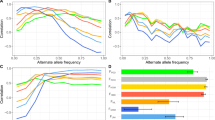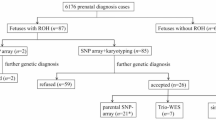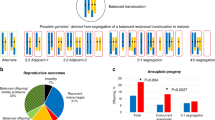Abstract
Chromosomal translocations and inversions are present in ∼0.6–1% of individuals. Although the majority are inherited, and the familial transmission across generations is well reported, reports of homozygosity are relatively rare, with most data in the form of individual case reports. A systematic review of all published cases was performed with particular attention to origin, ascertainment and phenotype of the reported homozygosity. A total of 10 cases of Robertsonian translocation (RBT), 6 reciprocal translocation and 19 cases of inversion homozygosity were identified. In RBT homozygosity, the majority of individuals are phenotypically normal, arise from inbreeding within a family that carries a familial translocation, and are ascertained following identification of an existing familial rearrangement rather than any feature specific to the homozygosity. In addition, they are fertile and as expected, their offspring are heterozygous for the translocation. For reciprocal translocations, homozygosity arises in individuals born to related parents from a family who harbor a unique familial translocation. Ascertainment is following investigation of phenotypic abnormalities resulting from consanguinity per se and/or the unmasking of a specific gene mutation. For chromosomal inversions, homozygosity may originate from either related or non-consanguinous parentage. Although many cases are ascertained because of an associated phenotypic abnormality, a high proportion of cases are of normal phenotype and a direct causal relationship is uncertain. There are fewer reports of both Robertsonian and inversion homozygosity than may be expected from the relative frequencies of each class within the population.
Similar content being viewed by others
Log in or create a free account to read this content
Gain free access to this article, as well as selected content from this journal and more on nature.com
or
References
Gardner, R. J. M. & Sutherland, G. R. Chromosome Abnormalities and Genetic Counselling 3rd edn. (Oxford University Press, Oxford, 2004).
Hamerton, J. L., Canning, N., Ray, M. & Smith, S. A cytogenetic survey of 14,069 newborn infants. I. Incidence of chromosome abnormalities. Clin. Genet. 8, 223–243 (1975).
Jacobs, P. A., Browne, C., Gregson, N., Joyce, C. & White, H. Estimates of the frequency of chromosome abnormalities detectable in unselected newborns using moderate levels of banding. J. Med. Genet. 29, 103–108 (1992).
Van Dyke, D. L., Weiss, L., Roberson, J. R. & Babu, V. R. The frequency and mutation rate of balanced autosomal rearrangements in man estimated from prenatal genetic studies for advanced maternal age. Am. J. Hum. Genet. 35, 301–308 (1983).
Nielsen, J. & Wohlert, M. Chromosome abnormalities found among 34,910 newborn children: results from a 13-year incidence study in Arhus, Denmark. Hum. Genet. 87, 81–83 (1991).
Hansteen, I. L., Varslot, K., Steen-Johnsen, J. & Langard, S. Cytogenetic screening of a new-born population. Clin. Genet. 21, 309–314 (1982).
Therman, E., Susman, B. & Denniston, C. The non-random participation of human acrocentric chromosomes in Robertsonian translocations. Ann. Hum. Genet. 53, 49–65 (1989).
Youings, S., Ellis, K., Ennis, S., Barber, J. & Jacobs, P. A study of reciprocal translocations and inversions detected by light microscopy with special reference to origin, segregation, and recurrent abnormalities. Am. J. Med. Genet. A 126A, 46–60 (2004).
Thomas, N. S., Bryant, V., Maloney, V., Cockwell, A. E. & Jacobs, P. A. Investigation of the origins of human autosomal inversions. Hum. Genet. 123, 607–616 (2008).
Kaiser, P. Pericentric inversions. Problems and significance for clinical genetics. Hum. Genet. 68, 1–47 (1984).
Madan, K. Paracentric inversions: a review. Hum. Genet. 96, 503–515 (1995).
Muss, B. & Schwanitz, G. Characterization of inversions as a type of structural chromosome aberration. Int. J. Hum. Genet. 7, 141–161 (2007).
Shaw, C. J. & Lupski, J. R. Implications of human genome architecture for rearrangement-based disorders: the genomic basis of disease. Hum. Mol. Genet. 1, R57–64 (2004).
Hsu, L. Y., Benn, P. A., Tannenbaum, H. L., Perlis, T. E. & Carlson, A. D. Chromosomal polymorphisms of 1, 9, 16, and Y in 4 major ethnic groups: a large prenatal study. Am. J. Med. Genet. 26, 95–101 (1987).
MacDonald, I. M. & Cox, D. M. Inversion of chromosome 2(p11q13): frequency and implications for genetic counseling. Hum. Genet. 69, 281–283 (1985).
Hook, E. B., Schreinemachers, D. M., Willey, A. M. & Cross, P. K. Inherited structural cytogenetic abnormalities detected incidentally in fetuses diagnosed prenatally: frequency, parental-age associations, sex-ratio trends, and comparisons with rates of mutants. Am. J. Hum. Genet. 36, 422–443 (1984).
Daniel, A., Hook, E. B. & Wulf, G. Risks of unbalanced progeny at amniocentesis to carriers of chromosome rearrangements: data from United States and Canadian laboratories. Am. J. Med. Genet. 33, 14–53 (1989).
Hook, E. B. & Cross, P. K. Rates of mutant and inherited structural cytogenetic abnormalities detected at amniocentesis: results on about 63,000 fetuses. Ann. Hum. Genet. 51, 27–55 (1987).
Martinez-Castro, P., Ramos, M. C., Rey, J. A., Benitez, J. A. & Sanchez Cascos, A. Homozygosity for a Robertsonian translocation (13q14q) in three offspring of heterozygous parents. Cytogenet. Cell Genet. 38, 310–312 (1984).
Leschot, N. J., von den Velden, J., Marinkovic-Ilsen, A., Darling, S. M. & Nijenhuis, L. E. Homozygosity for a Y/22 chromosome translocation: t(Y;22) (q12;p12/13). Clin. Genet. 29, 251–257 (1986).
Wahrman, J., Atidia, J., Goitein, R. & Cohen, T. Pericentric inversions of chromosome 9 in two families. Cytogenetics 11, 132–144 (1972).
Rockman-Greenberg, C., Ray, M., Evans, J. A., Canning, N. & Hamerton, J. L. Homozygous Robertsonian translocations in a fetus with 44 chromosomes. Hum. Genet. 61, 181–184 (1982).
Cotter, P. D., Babu, A., McCurdy, L., Caggana, M., Willner, J. P. & Desnick, R. J. Homozygosity for pericentric inversions of chromosome 9. Prenatal diagnosis of two cases. Ann. Genet. 40, 222–226 (1997).
Eklund, A., Simola, K. O. & Ryynanen, M. Translocation t(13;14) in nine generations with a case of translocation homozygosity. Clin. Genet. 33, 83–86 (1988).
Omrani, M. D. & Gargari, S. S. Uniparental disomy resulting from heterozygous Robertsonian translocation (13q14q) in both parents. J. Res. Med. Sci. 12, 100–103 (2007).
Sensi, A., Cavani, S., Villa, N., Pomponi, M. G., Fogli, A., Gualandi, F. et al. Nonhomologous Robertsonian translocations (NHRTs) and uniparental disomy (UPD) risk: an Italian multicentric prenatal survey. Prenat. Diagn. 24, 647–652 (2004).
Dallapiccola, B., Ferranti, G., Altissimi, D., Colloridi, F. & Paesano, R. First-trimester prenatal diagnosis of homozygous (14;21) translocation in a fetus with 44 chromosomes. Prenat. Diagn. 9, 555–558 (1989).
Rajangam, S., Michaelis, R. C., Velagaleti, G. V., Lincoln, S., Hegde, S., Lewin, S. et al. Down syndrome with biparental inheritance of der(14q21q) and maternally derived trisomy 21: confirmation by fluorescent in situ hybridization and microsatellite polymorphism analysis. Am. J. Med. Genet. 70, 43–47 (1997).
Neu, R. L., Valentine, F. A. & Gardner, L. I. Segregation of a t(14q22q) chromosome in a large kindred. Clin. Genet. 8, 30–36 (1975).
Dallapiccola, B., Chessa, L., Brinchi, V., Fronatal, M. & Gandini, E. Mating between two balanced translocation carriers in two unrelated families. Hum. Genet. 65, 165–168 (1983).
Martinet, D., Vial, Y., Thonney, F., Beckmann, J. S., Meagher-Villemure, K. & Unger, S. Fetus with two identical reciprocal translocations: description of a rare complication of consanguinity. Am. J. Med. Genet. A 140, 769–774 (2006).
Zaki, M., Shehab, M., El-Aleem, A. A., Abdel-Salam, G., Koeller, H. B., Ilkin, Y. et al. Identification of a novel recessive RELN mutation using a homozygous balanced reciprocal translocation. Am. J. Med. Genet. A 143A, 939–944 (2007).
Schneider, E., Märker, T., Daser, A., Frey-Mahn, G., Beyer, V., Farcas, R. et al. Homozygous disruption of PDZD7 by reciprocal translocation in a consanguineous family: a new member of the Usher syndrome protein interactome causing congenital hearing impairment. Hum. Mol. Genet. 18, 655–666 (2009).
Wilmot, P. L., Shapiro, L. R. & Casamassima, A. C. Disomic balanced reciprocal translocation. Clin. Genet. 38, 126–127 (1990).
de la Chapelle, A., Schröder, J., Stenstrand, K., Fellman, J., Herva, R., Saarni, M. et al. Pericentric inversions of human chromosomes 9 and 10. Am. J. Hum. Genet. 26, 746–766 (1974).
Vine, D. T., Yarkoni, S. & Cohen, M. M. Inversion homozygosity of chromosome no. 9 in a highly inbred kindred. Am. J. Hum. Genet. 28, 203–207 (1976).
Sudha, T. & Jayam, S. Pericentric inversion in homologues of chromosome 9. Jpn. J. Human. Genet. 38, 341–343 (1993).
Baltaci, V., Ors, R., Kaya, M. & Balci, S. A case associated with Walker Warburg syndrome phenotype and homozygous pericentric inversion 9: coincidental finding or aetiological factor? Acta Paediatr. 88, 579–583 (1999).
Khaleghian, M. & Azimi, C. Homozygosity for pericentric inversions of chromosome 9 in a patients parents with stillbirth—report of a new case and review of literature. Iranian J. Publ. Health 35, 28–33 (2006).
Sharony, R., Amiel, A., Einy, R. & Fejgin, M. Prenatal diagnosis of pericentric inversion in homologues of chromosome 9: a decision dilemma. Am. J. Perinatol. 24, 137–140 (2007).
Sakagami, K. & Yoshida, A. A case of inverted chromosome no. 9 (homozygote). Fol. Ophthalmol. Jpn. 39, 348–353 (1988).
Babu, K. A., Verma, R. S., Rodriguez, J., Rosenfeld, W. & Jhaveri, R. C. A possible clinical implication of homozygous inversions of 9qh regions with Cornelia de Lange syndrome (CLS). Hum. Hered. 35, 265–267 (1985).
Willatt, L. R., Davison, B. C., Goudie, D., Alexander, J., Dyson, H. M., Jenks, P. E. et al. A male with trisomy 9 mosaicism and maternal uniparental disomy for chromosome 9 in the euploid cell line. J. Med. Genet. 29, 742–744 (1992).
Gelman-Kohan, Z., Rosensaft, J., Ben-Cohen, R. N. & Chemke, J. Homozygosity for inversion (2)(p12q14). Hum. Genet. 92, 427 (1993).
Carpenter, N. J., Say, B. & Barber, N. D. A homozygote for pericentric inversion of chromosome 4. J. Med. Genet. 19, 469–471 (1982).
Betz, A., Turleau, C. & de Grouchy, J. Heterozygosity and homozygosity for a pericentric inversion of human chromosome 3. Ann. Genet. 17, 79–80 (1974).
Price, H. A., Roberts, S. H. & Laurence, K. M. Homozygous paracentric inversion 12 in a mentally retarded boy: a case report and review of the literature. Hum. Genet. 75, 101–108 (1987).
Iselius, L., Lindsten, J., Aurias, A., Fraccaro, M., Bastard, C., Bottelli, A. M. et al. The 11q;22q translocation: a collaborative study of 20 new cases and analysis of 110 families. Hum. Genet. 64, 343–355 (1983).
Borgaonkar, D. S. Chromosomal Variation in Man. A Catalog of Chromosomal Variants and Anomalies (Wiley-Liss, New York, 1997).
Pardo-Manuel de Villena, F. & Sapienza, C. Transmission ratio distortion in offspring of heterozygous female carriers of Robertsonian translocations. Hum. Genet. 108, 31–36 (2001).
Acknowledgements
I thank the anonymous reviewer(s) for the highly constructive comments and suggestions before the final publication of this article.
Author information
Authors and Affiliations
Corresponding author
Rights and permissions
About this article
Cite this article
O'Neill, I. Homozygosity for constitutional chromosomal rearrangements: a systematic review with reference to origin, ascertainment and phenotype. J Hum Genet 55, 559–564 (2010). https://doi.org/10.1038/jhg.2010.80
Received:
Revised:
Accepted:
Published:
Issue date:
DOI: https://doi.org/10.1038/jhg.2010.80
Keywords
This article is cited by
-
How much, if anything, do we know about sperm chromosomes of Robertsonian translocation carriers?
Cellular and Molecular Life Sciences (2020)
-
A family with Robertsonian translocation: a potential mechanism of speciation in humans
Molecular Cytogenetics (2016)
-
One pedigree we all may have come from – did Adam and Eve have the chromosome 2 fusion?
Molecular Cytogenetics (2016)



